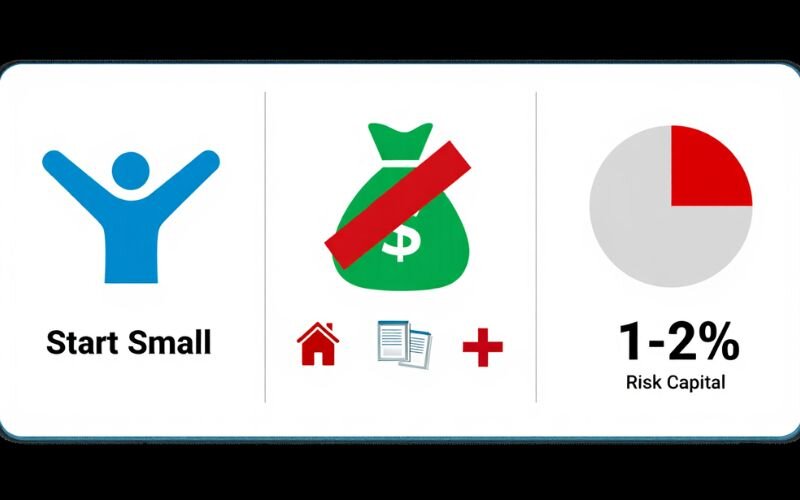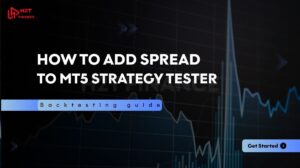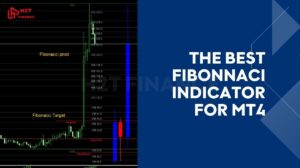Achieving success in forex trading isn't about luck — it's about having a well-thought-out strategy. Many new traders jump into the market without a clue about what they're doing, and that's where it all goes wrong. Then, a Forex trading plan template is your roadmap. It will guide your decisions, keep you on track, and stop you from making costly mistakes. Let’s explore what a trading plan is, why it’s essential, and how you can build one step by step. Let's get started!
1. What is trading plan?
A trading plan is a list of clear-cut rules and guidelines that help you manage your trades and make better decisions in the market. It operates like your own guide, helping you stay organized, focused, and calm even when markets turn unpredictable.
Your trading plan will outline your targets, risk limits, and entry and exit rules that you will follow when you execute trades. It can even have a to-do list of your daily procedure and tips on managing emotions while trading.
For example, with a good forex trading plan template, you can establish:
- Trading targets
- Your strengths & weaknesses
- Risk management rule
- Trading strategies
- Entry and exit rules
- Daily trading routine
- Trade review checklist
- Emotional control tips
Having a solid plan means you’ll always know what to do next no guessing, no panic.
2. Why do you need a trading plan?
If you want to succeed in forex trading, a good plan isn’t just helpful it's a necessity. The forex market moves fast, and without a good plan, it's too easy to get caught up in emotions like greed and fear. That's when traders make risky decisions, chase losses, or jump into trades blindly. A trading plan keeps you focused, calm, and in control.
A trading plan also helps you manage your money effectively. It tells you how much to risk per trade and when to step aside. This way, you do not blow up your account on a few bad moves.
A second key reason for a trading plan is consistency. Consistent traders employ the same rules every time they trade. This simplifies keeping track of what works and what doesn't. Over time, you can then adapt your plan to fit your style and goals.
3. How to build your forex trading plan: 7 simple steps
Having a clear plan before you begin trading is highly recommended. A well-planned Forex trading plan template is a guide for your trading journey, showing you where you want to go and how to get there.

Following is a simple-to-follow 7-step process to assist you in setting up your plan:
3.1. Set your trading goals
The first step is to decide what goals you want to achieve through trading. Do you wish to make part-time side income, long-term growth, or full-time gains? Be realistic and specific regarding your goals.
To remain focused, apply the SMART principle[1]:
- Specific: Establish clear and simple goals.
- Measurable: Track and measure your progress.
- Achievable: Establish goals within your reach.
- Realistic: Remain realistic concerning market risks.
- Time-bound: Place deadlines for your goals.
Example: “I aim to grow my account by 10% in the next 3 months while risking no more than 2% per trade.”
3.2. Decide your trading styles
Every trader has a style and schedule that is comfortable for them. Selecting the correct one will keep you on course and avoid frustration. There are 4 main trading styles listed below:
- Position trading: Traders keep this trading style for weeks, months, or years. It means that you prefer long-term trading and big trends, not daily price movements. It requires patience, but fewer trades and less stress.
- Swing trading: Swing traders hold for a few days to a week, catching short- to mid-term price movements. It's great for those who can view the markets daily but do not have to gaze at charts all day long.
- Day trading: With day trading, you open and close all positions in one day. It's fast and requires watching the markets all day, so it's optimal for full-time traders.
- Scalping: Scalpers perform many small transactions in minutes or seconds, looking for a tiny profit. It's the most aggressive type and requires fast decision-making ability and sharp concentration.
3.3. Decide how much time you will spend
Next, be honest about how much time you can spend on trading. Some people can only check the markets once a day, while others can have hours to watch the charts.
If you work full-time, a position or swing trading would most likely be for you. If you have an adjustable schedule and enjoy fast-action activity, day trading or scalping might suit you. Deciding this upfront ensures you pick a trading style and plan that works with your daily routine.
See more related articles:
- Bullish vs Bearish Markets: What They Mean for Forex Traders
- Margin Call: Causes and How to Avoid It
- Mistakes New Traders Make When Misusing Terms
3.4. Decide how much money you will invest
Before you trade, decide how much money you’re willing to invest as well as potentially lose. It's always smart to use funds you can afford to risk to not affect your daily life.
Key points to note:
- Start small if you’re a beginner.
- Never risk money you set aside for bills, rent, or emergencies at trading
- Many experts recommend limiting your risk to just 1–2% of your overall capital on any single trade.
As an illustration, with a $1,000 account, your risk per trade should be kept between $10 and $20. That will protect your account from big losses and keep you in the game longer.

You also set a monthly risk limit. When you reach it, pull back and examine your plan before trading again. Smart money management is a key element in achieving success as a trader.
3.5. Pick a risk-reward ratio
A risk-reward ratio tells you how much you're willing to risk to get a potential reward. For instance, a risk-reward ratio of 1:2 implies that you're putting $1 at risk in order to potentially earn $2. If a trade does not offer an adequate reward, it's better not to take it.
Most traders seek at least a 1:2 or 1:3 ratio for every trade. That means even when you lose a few trades, one good trade can cover your losses and grow your account.
To be consistent:
- Set take-profit and stop-loss order before trading
- Never adjust your stop-loss based on fear.
- Avoid trades with poor risk-reward setups.
Selecting the proper ratio and sticking to it controls emotions and makes trading decisions smart, not emotional.
3.6. Learn & grow
The forex market is constantly evolving, and successful traders keep learning without pause. Set time to learn about new strategies, watch trading videos, listen to trading podcasts, read trading books, or read market news. If you are new, you can follow the 5-3-1 rule [2](5 currency pairs to trade, 3 strategies to use, and 1 time to trade every day).
Stay up to date on news relating to the economy, like interest rate announcements or employment numbers. Those elements can move the currency prices.
You can also join online trading forums to exchange ideas and learn from other people's experiences. Learning from your gains and losses is also essential. Review your past trades from time to time and adjust your plan accordingly.
3.7. Start your trading journal
A trading journal is a very useful yet basic tool that every forex trader should have. It's where you monitor all trades you take in — the reasons you entered, how it resulted, and how you felt throughout the trade.
Over time, this helps you:
- Identify recurring trends in the way you trade.
- Identify strengths and weaknesses.
- Don't replicate costly mistakes.
Use a notebook, spreadsheet, or trading journal app — whatever is easiest for you. Review your journal weekly to determine what is working and what isn't. A good journal makes each trade a learning experience.
4. Sample trading plan template - Free download
Click the link to download your free Trading plan example! Keep in mind that a well-defined plan gives you greater control over your trading results.
Sample Trading Plan Free Download
Having a clear, organized Forex trading plan template is one of the smartest moves you can make as a trader. It keeps you focused, keeps you disciplined, and less emotional in adverse markets. Trading with your plan will make you trade more confidently, and you'll learn from both winning and losing trades. Don't forget every successful trader starts with a plan, not a guess. Use this guide to build your plan and adjust it as you grow. Patience and continuous learning are key throughout your trading journey.
Ready to take action? Don’t just read about trading smart - start now by downloading your free Forex Trading Plan Template. This ready-to-use guide will help you set goals, manage risk, and trade with confidence from day one.
At H2T Finance, we’re here to support every step of your trading journey. Whether you're a beginner or looking to sharpen your skills, our expert-backed resources and real-time insights are tailored to help you succeed. Download your plan today and trade smarter with H2T Finance by your side.
5. About H2T Finance
At H2T Finance, we believe that a strong foundation is key to success in the forex market. Our Forex Basics category is designed to help new traders understand the essential concepts of currency trading, from how the forex market operates to basic strategies for getting started. Backed by the trusted expertise of H2T Media Group, we provide clear, reliable information and real-time insights to support your journey from first trade to confident decision-making in the dynamic world of forex.
For inquiries or personalized assistance, feel free to contact us:
📞 Phone: +84933.948.888
📧 Email: info@h2tmediagroup.com
📍 Address: 4/567 Tổ 10 Khu Phố Hòa Lân 1, Thuận An, Bình Dương, Vietnam
At H2T Finance, your success is our priority.



